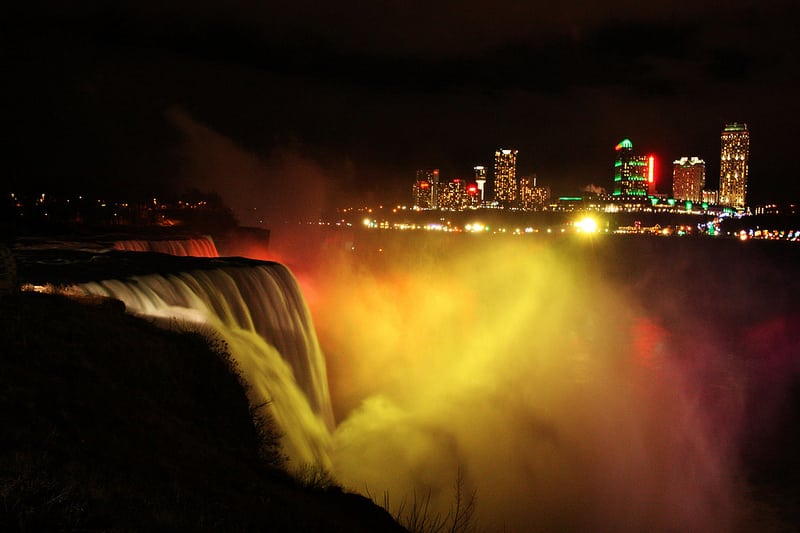The fall of Niagara Falls: Will it ever rise again?

Skift Take
In the Fifties, Niagara Falls was known as the “Honeymoon Capital of the World” as young newlyweds, attracted by the romance of the city, flocked to the banks of the Horseshoe falls.
More than 50 years on, the honeymoon is well and truly over.
The world’s most famous waterfalls continue to attract millions of visitors every year, but the American city that bears the same name has a problem.
At the most recent census, in 2010, the City of Niagara Falls, New York, had a population of 50,193. If that number drops below 50,000, it will lose its status as a city and the millions of dollars in federal funding that come with it.
In an effort to keep the population up, the city has come up with a controversial plan: offering to help pay off the student debt of college graduates, giving them $7,000 (£4,300) over two years, if they agree to go and live there.
But with only 20 graduates being accepted on to the scheme, it has drawn criticism and ridicule, with opponents pointing out that paying such a small number of people to live in the city is unlikely to stem the population loss.
They also say it is embarrassing that a city that, just 50 years ago, was home to more than 100,000 people and a thriving industrial economy, should now be reduced to paying people to live there.
The man behind the idea, Seth Piccirillo, the city’s director of community development, argues that his plan could ultimately lead to an influx of young professionals, which in turn would create new businesses and jobs.
“Right now we are at a critical point,” Mr Piccirillo, 30, said. “If we do not have a real strategy for retaining people then we will not survive as a city. Not just in terms of funding, but as a functional city. We will not attract employment and we will not be able to compete or survive in the modern age.”
In the early 20th century, the “Power City” attracted chemical production plants that used the hydroelectric power of the waterfalls. The result was jobs for locals and an influx of immigrants who helped raise the population.
But the City of Niagara Falls saw that industry decline in the Fifties and Sixties, with many companies, as well as residents, relocating.
Today, the city appears almost to be a shell. The streets are lined with boarded-up shops and derelict houses. Bars and restaurants are few and far between. Some neighbourhoods are nearly empty.
The official statistics paint an even more depressing picture. Almost 18 per cent of families in the city today survive on “sub-poverty” levels of income; 4,000 students qualify for free school lunches; nearly 20 per cent of residents receive food stamps; 5,000 of the city’s 28,000 homes are vacant, while more than 800 are unsafe to occupy. There is further frustration for city leaders. Standing on the viewing platform above the gorge, looking at the Falls, two other sights catch the eye.
The first is the city’s Canadian namesake. Niagara Falls, Ontario, is a better example of what a city lining one of the world’s most natural wonders can be. Harnessing its tourism potential, it has more hotel beds, restaurants and, crucially, visitors — 12 million versus eight million annually — than its US counterpart.
Niagara Falls, Ontario, has a growing population. It has gone from 22,000 residents in the Fifties, to 82,000 today.
Earlier this year, when stuntman Nik Wallenda walked across the Falls on a high wire, he went from the US side to the Canadian side, giving America’s neighbour more publicity.
The second sight that dominates the skyline is on the American side. The Seneca Niagara Casino looks other-worldly alongside the crumbling homes and empty storefronts.
While the casino appears to be in Niagara Falls, it technically sits upon the land of the Native American Seneca Nation tribe.
The Senecas bought the land as part of an agreement with New York state, which stipulated that, as long as the tribe had exclusivity over casinos in New York, it would pay some of its slot machine revenue to the state.
But the Senecas began withholding the money in 2010, accusing the state of reneging on the agreement by allowing other casinos to open.
In two years, it has withheld $460 million (£282 million) from the state. Niagara Falls believes the row has cost the city upwards of $60 million.
Such a dismal situation demanded a radical solution.
Mr Piccirillo’s initiative, which has been named Live NF, involves luring graduates to the area by offering to pay their student loan debts of up to $291 a month for two years. In return, they would live in the city during that time.
“Fewer than 20 per cent of Niagara Falls residents have a college degree,” he said. “Without wishing to denigrate those who don’t, there is a correlation between college graduates and earning power and discretionary income.
“We knew we needed to attract and retain these people. We know that college graduates have debt and we knew that we didn’t have enough of them, so we thought ‘let’s figure out a way…’. ”
From an initial interested pool of more than 300 young people, 31 applied to take part in the scheme, which Mr Piccirillo says will cost about $200,000.
He is hoping that the first graduates on the scheme will move to the city in the spring.
But the issue has proved divisive. The city’s Urban Renewal Agency was split on the decision, while one local newspaper, the Niagara Reporter, said it “hated” the idea, describing it as “a sort of reverse prostitution”.
Two of Live NF’s biggest critics are Glenn Choolokian and Sam Fruscione, both city councillors.
“Our city has been declining in population for 30 or 40 years,” said Mr Choolokian. “We are losing people left and right, and we are now looking to spend $200,000 to try and keep 20 people here.”
Mr Fruscione fears that those accepted on the scheme will simply depart after two years. “If I was a smart, hustling
college graduate I would do everything I could to reduce my financial burden,” he said.
“It means they are going to bail out after two years. My daughter has a friend who wants to get on the programme for one reason only – to knock $7,000 off her student debt, and when she’s done she is going to move.” He added that the scheme was “extremely embarrassing” for the city. “And it is a slap in the face to the residents who pay out of their own money to stay here.”
Mr Piccirillo has appointed an independent panel to select the individuals who will take part. He refused a request for applicants to be interviewed by The Daily Telegraph, but did provide anonymous sections of their application forms.
The most obvious question posed by critics is: “Why would anyone want to live in Niagara Falls?” One candidate wrote: “Niagara Falls is declining in population and economic growth, but it has not failed yet as a city. Just like I have not failed yet as a college graduate. I have faith that both Niagara Falls and I will succeed in the future.”
Whether Mr Piccirillo’s plan works remains to be seen. The figures showing rapid decline would suggest not.
“I don’t think it is inevitable,” Mr Piccirillo said. “I love this city. I cannot say we are just going to let it die.”
He responds to the uneasiness felt by many about paying people to live in the city by saying: “What is more embarrassing for me is if we failed as a city.
“And what is much more embarrassing is hearing tourists say it is much better on the Canadian side. That embarrasses me every day.”
![]()




